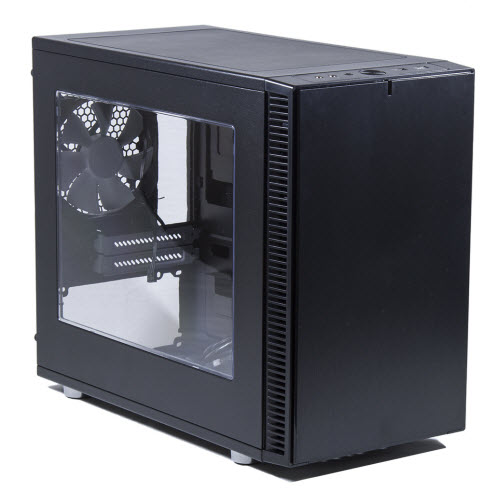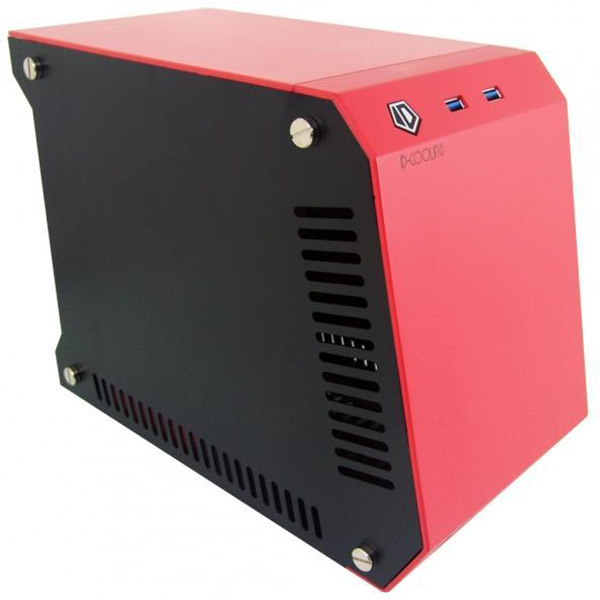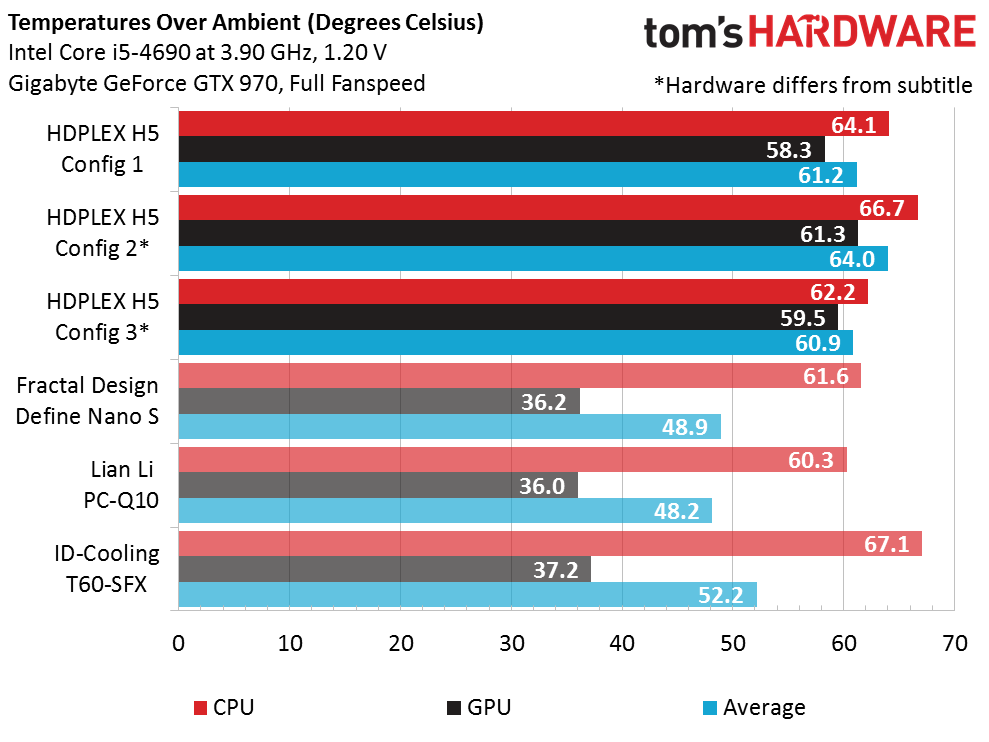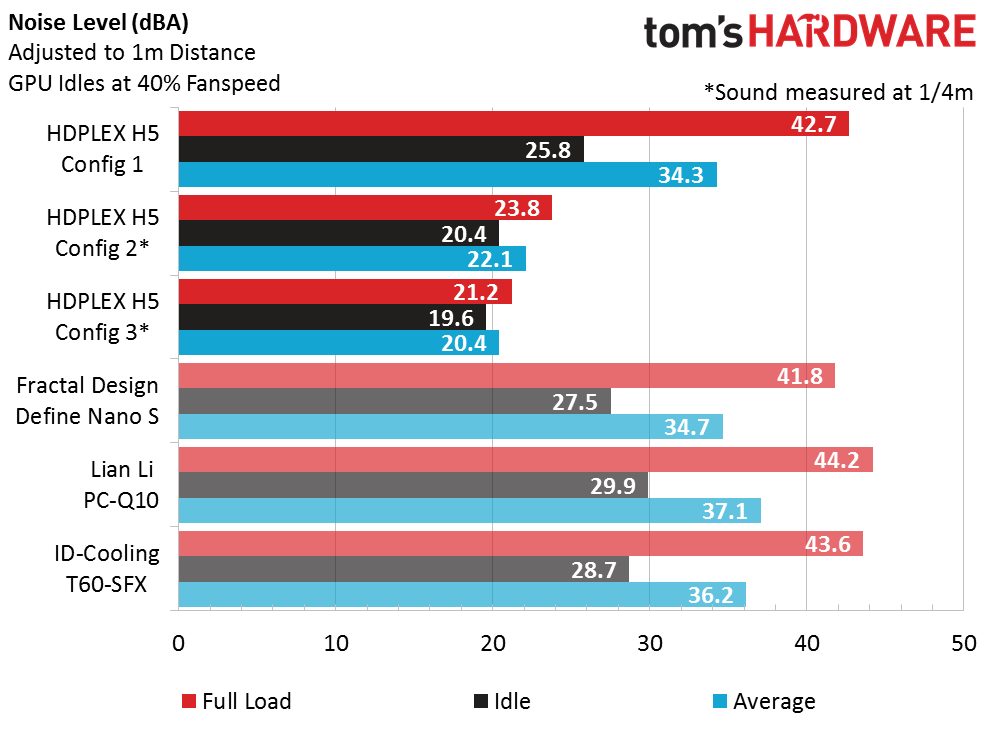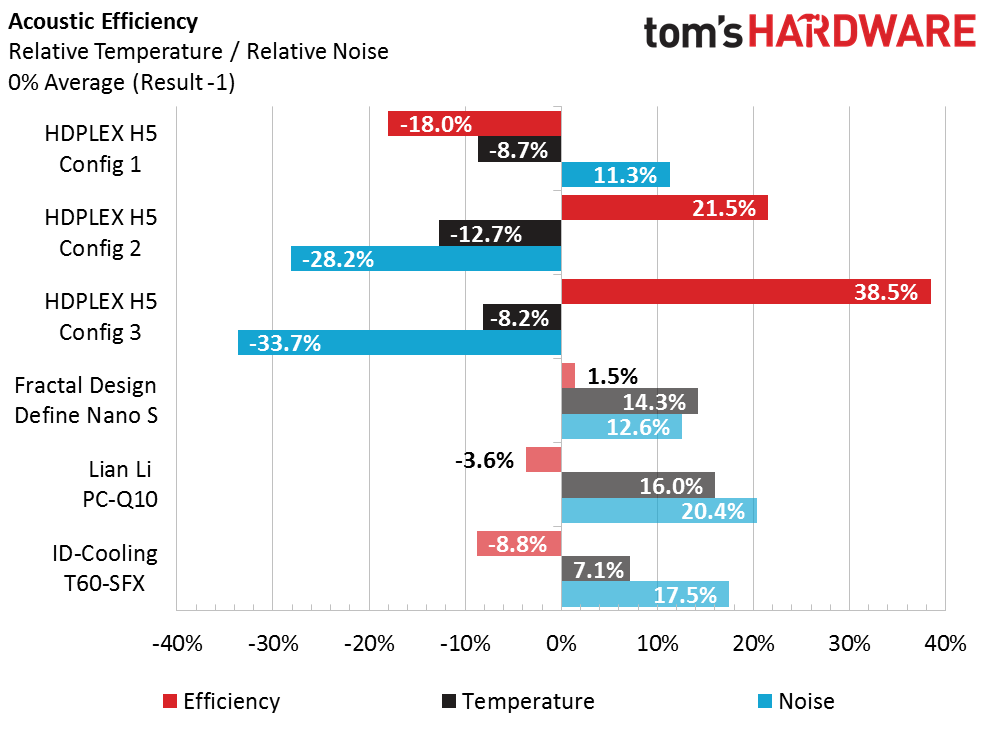HDPLEX H5 Fanless Computer Case Review
HDPLEX is widely known within the HTPC and audiophile communities for making premium, fanless computer cases. Can the second generation H5 build on the success of its predecessor?
Why you can trust Tom's Hardware
Test Results And Conclusion
How We Tested The HDPlex H5
Today's review is going to break the mold when it comes to testing. Since the H5 is a relatively unique case compared to other case we have tested, we will test it in several configurations. To maintain consistent data between all of the cases we've tested, the first testing configuration consists of our usual reference platform setup, with one minor change. Since the H5 isn't designed to work with a CPU cooler other than its own passive cooler, there's not a lot of room in the case for any sort of air or water cooler. That said, the Noctua NH-L12 that we usually use for reviews doesn't fit in the H5. We'll use the well-reviewed Reeven Brontes in its place since it's the best match for the NH-L12 in terms of performance.
For the second testing configuration, we'll test how well the H5's passive CPU cooler works with our hardware, except for the CPU cooler and GPU. Since our GTX 970 exceeds the GPU cooling system's TDP limit of 95W, we've switched it out with a compact GTX 950.
The final testing configuration comes by way of HDPLEX. Since we didn't have enough hardware to completely demonstrate all of the capabilities of the H5, they sent us another case filled with hardware to help with the review and testing. Since we had another H5 full of hardware on hand for the review, we decided to put it to the test as well since it would give us another data point and therefore more insight into the case's performance.
Here are the hardware specifications for each of the testing configurations.
| Header Cell - Column 0 | Configuration 1 | Configuration 2 | Configuration 3 |
|---|---|---|---|
| CPU | Intel Core i5-4690 (Devil's Canyon): 3.50 GHz, Four CoresLocked at 3.90 GHz (39x 100 MHz) at 1.20 V Core | Intel Core i5-4690 (Devil's Canyon): 3.50 GHz, Four Cores Locked at 3.90 GHz (39x 100 MHz) at 1.20 V Core | Intel Core i5-6400 (Skylake): 2.70 GHz, Four Cores Locked at 3.30 GHz (33x 100 MHz) at 1.20 V Core |
| CPU Cooler | Reeven Brontes | HDPLEX Passive CPU Cooling System | HDPLEX Passive CPU Cooling System |
| Graphics | Gigabyte GV-N970IXOC-4GD: GeForce GTX 970 1101-1241 MHz GPU, GDDR5-7012, Maximum Fan for Thermal Tests | Zotac ZT-90601-10L: GeForce GTX 950 1089-1266 MHz GPU, GDDR5-7012, HD Plex Passive GPU Cooling System | Zotac ZT-90601-10L: GeForce GTX 950 1089-1266 MHz GPU, GDDR5-7012, HDPLEX Passive GPU Cooling System |
| Motherboard | MSI Z97I AC: LGA 1150, Intel Z97, Firmware 4.8 (06/01/2015) | ASRock Z170 Pro 4: LGA 1151, Intel Z170, Firmware 2.8 (11/04/2015) | |
| RAM | Crucial Ballistix Sport Low Profile BLS2K8G3D1609ES2LX0 16 GB (2x 8 GB) DDR3-1600 Benchmarked at XMP CAS 9 defaults (1.35V) | Corsair Vengeance LPX CMK16GX4M2A2666C16 16 GB (2x 8 GB) DDR4-2666 Benchmarked at XMP CAS 16 defaults (1.20 V) | |
| Hard Drives | Crucial MX200 CT500MX200SSD1 500GB SATA 6Gb/s SSD | Samsung 850 EVO 256GB SATA 6Gb/s SSD | |
| Sound | Integrated HD Audio | Integrated HD Audio | |
| Network | Integrated Gigabit Networking | Integrated Gigabit Networking | |
| Power | be quiet! SFX Power 2 BN227 400W SFX 12V v3.3 / EPS 12V N/A, 80 PLUS Bronze | SilverStone SFX Series SX600-G 600W ATX 12V v2.4 / EPS 12V N/A, 80 PLUS Gold | |
| Software | |||
| OS | Microsoft Windows 8.1 Pro x64 | ||
| Graphics | Nvidia GeForce 353.30 | ||
| Chipset | Intel INF 10.0.27 |
As with all previous tests, noise is measured .5m from the case's front corner, on the side that opens. The numbers are corrected to the 1m industry standard—used by many loudspeaker and fan manufacturers—by subtracting six decibels.
Since this is a passively cooled case, it takes quite a while to heat up to its maximum temperature. And since we like brutally testing hardware that is given to us to review, we decided to run our full load test on this case for a full 24 hours to make sure the temperatures had reached their maximum. Finally, as is usual for compact case testing, the ambient air temperature for each of the tests was carefully maintained at approximately 26 degrees Celsius (78.8 degrees Fahrenheit) for the duration of the test.
Test Results
Today's test results will feature separate results for each of the three different hardware test configurations (the specifications of each of the different testing configurations can be found in the table above).
Get Tom's Hardware's best news and in-depth reviews, straight to your inbox.
Despite the hardware changes between the different configurations, the H5 performed consistently. Although we didn't have any overheating issues, the H5 did run consistently hotter than most of the other cases we've tested up until now. However, such results are somewhat expected from a case designed to be passively cooled. And since most users won't be asking this case to deal with a punishing, 24/7, 100 percent workload, the H5 ought to run quite a bit cooler under normal working conditions.
Finally, it's worth noting that these benchmarks were run with the case sitting in an open-air environment, on top of a table, with unfettered access to the air in the room. While the H5 performed very well in this situation, it remains untested as to how it would perform stuffed inside of something like an entertainment center, where it has other passively cooled electronics to compete with for cool air, and where the fresh air supply is heavily restricted.
As you might have expected, the H5 gets a whole lot quieter when you remove the large noisy fans from the equation. For the second and third test configurations, the only thing left in the case to make noise was the fan on the power supply. Even then, the H5 was so quiet that my meter wasn't sensitive enough to detect any sound coming from it at a distance of 0.5m. I ended up having to halve the distance to the case to get any measureable noise reading, and even then it was still just barely above my meter's 32-dBA minimum. Still, if you're not willing to settle for anything other than absolute silence, HDPLEX offers a number of fanless 12V DC power supply options, so you can achieve total silence.
The H5 is terribly inefficient when you try to air cool the components inside of it, but then again, it wasn't designed to be used in that manner. When used properly however, the case does become much more efficient. If you're wondering about the significant difference between the second and third configurations, the third configuration gets a bit of an efficiency boost because SilverStone's SFX PSU turned out to be just a bit quieter than the one from be quiet! used in the second test configuration.
Unfortunately for the H5, its $288 price tag (combined with the way we calculate the value of a case) prevents it from winning an award based on its calculated value alone. That said, by design the H5 is very much a premium case geared towards a niche market, so a pure performance-value win wasn't exactly expected.
MORE: Best CasesMORE: Cases in the News
MORE: All Case Content
MORE: Cases in the Forums
Chris Miconi is an Associate Contributing Writer for Tom's Hardware,covering Cases. Follow us on Facebook, Google+, RSS, Twitter and YouTube.
-
leaded gas only I dig it.Reply
The case reminds me of a old David Hafler component power amp.
Disappointed that it doesn't support AMD CPUs MBs. -
chandra7979 Streacom has been making cases like this for a while (I have the FC5 EVO). This one looks like a taller FC5 (or a slimmer FC10). Could you maybe add metric dimensions to the specs table?Reply -
Chris Droste i feel like the thermal limitations of the passive air cooling, along with the cost, wind up making Intel's Skull Trail NUC a better purchaseReply -
cmiconi ReplyStreacom has been making cases like this for a while (I have the FC5 EVO). This one looks like a taller FC5 (or a slimmer FC10). Could you maybe add metric dimensions to the specs table?
I put them into the table originally, but it seems they never got published. I'll see if I can get them to update the table. -
RedJaron Definitely a nice case, but at $288 ( on mfr's site ) the thing just about costs more than everything that would go inside it. As much as I'd like one, I don't know if I could ever justify spending that much.Reply -
jsmithepa These are mainly for folks who must have a fan-less. If you have to add fans, for whatever reason/requirement, that's one expensive enclosure. I have one of their H1-ITX enclosure for a bedroom HTPC, the silence is precious.Reply -
jdwii Replyi feel like the thermal limitations of the passive air cooling, along with the cost, wind up making Intel's Skull Trail NUC a better purchase
I can't see how when it can handle a I7 since it can handle 95 watt CPUs not to mention a 750Ti would also be fine in it.
However i agree with the cost part.
